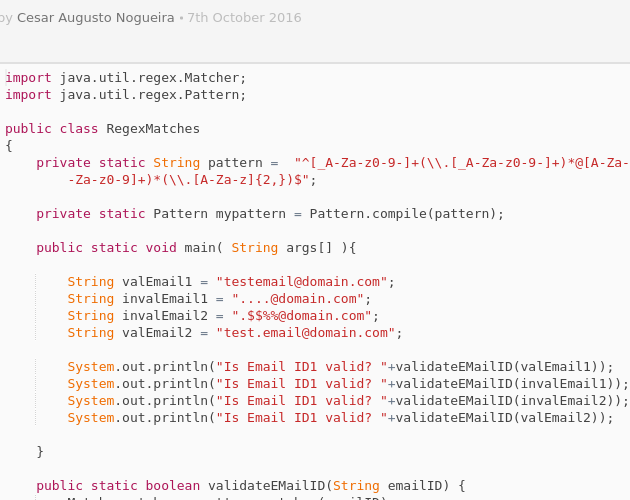

Replaces the first subsequence of the input sequence that matches the pattern with the given replacement string. Replaces every subsequence of the input sequence that matches the pattern with the given replacement string. Implements a terminal append-and-replace step. Implements a non-terminal append-and-replace step. Matcher appendReplacement(StringBuffer sb, String replacement) This methods are used to replace matching text in the input string. Tries to match the entire region against the pattern. Resets this matcher and then tries to find the next subsequence of the input sequence that matches the pattern, starting at the given index. Tries to find the next subsequence of the input sequence that matches the pattern. Returns true if it finds a match. Tries to match the input sequence, starting at the beginning of the region, against the pattern. Hence, it returns true if the pattern is found. So the verifier methods are used to check an input string to verify if a patter is found. Gives the offset after the last character of the subsequence captured by the given group during the previous operation. Gives the offset after the last character matched. Gives the start index of the subsequence captured by the given group during the previous operation. This method returns the start index of the previous match.

It provides the index position of the match. You use the index methods to get where a match was found. So there are three categories of method we would discuss. You can use the methods provided by the Matcher class to perform certain operations.

You escape a metacharacter by preceding it with a backslash (\) Minimum of n and maximum of mįurthermore note that metacharacters must be escaped. N or more occurrences of the preceding expression. ExpressionĠ or more occurrences of the preceding expression.Ġ or 1 occurrence of the preceding expression.Įxactly n number of occurrences of the preceding expression. You use them to match more than one character at a time. Groups regular expressions enclosed in brackets. So we provide a list of regular expressions that matches any boundaries. This is because there are quite a number of different expressions to use. So we are going to separate the syntax into categories. Then you pass it the string you want to match.Ī PatternSynta圎xception object is an exception that occurs if there is error in the regular expression However, you can create a Matcher object by calling the match() method of the Pattern object. Just like the Pattern class, there are no public constructor in the Matcher class. The Matcher class helps you to match a string against a pattern. Next class in the package is the Matcher class. This method accepts a regular expression as parameter and returns a Pattern object. You can do this by calling its static compile method(). How then can you create a pattern object? As such, you cannot just create a Pattern object using new keyword. However, the Pattern class has not public constructors. Hence, pattern object represents a particular regular expression. So you can create a Pattern object from a pattern class. They are Pattern, Matcher and PatternSynta圎xception classes.

In Java, we have three classes used to work with regular expressions. Regular expression comes to the rescue in cases like this. These includes: searching for particular pattern in a text or replacing occurrence of certain string.įor example, you may want to search for phone numbers inside several pages of text. Moreover, you can also used them to perform other operations. You can use them to represent patterns in a text. In this case, dollar changes from matching at only the last the entire string to the last of any line within the string.We are going to learn about Regular expressions in Java under the following topics:Ī regular expression is a special sequence of characters. To match the position after the last character of any line, we must enable the multi-line mode in the regular expression.


 0 kommentar(er)
0 kommentar(er)
